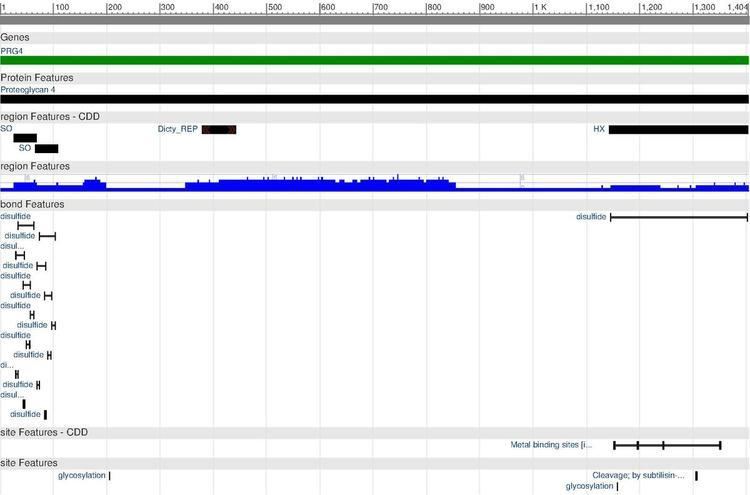Entrez 10216 | Ensembl ENSG00000116690 | |
 | ||
External IDs HomoloGene: 130465 GeneCards: PRG4 | ||
Proteoglycan 4 or lubricin is a proteoglycan that in humans is encoded by the PRG4 gene. This proteoglycan acts as a joint/boundary lubricant.
Contents
Function
Lubricin is present in synovial fluid and on the surface (superficial layer) of articular cartilage and therefore plays an important role in joint lubrication and synovial homeostasis. When first isolated, cartilage lubricin was called "superficial zone protein" (SZP). Lubricin, MSF, and SZP are now collectively known as Proteoglycan 4 (hence PRG4 for the gene nomenclature). The expression of lubricin has also been detected and the protein localized in tendon, meniscus, lung, liver, heart, bone, ligament, muscle, and skin.
Structure
The protein encoded by this gene is a proteoglycan of approximately 345 kDa specifically synthesized by chondrocytes located at the surface of articular cartilage, and also by some synovial lining cells. The cDNA encodes a protein of 1,404 amino acids (human A isoform) with a somatomedin B homology domain, heparin-binding domains, multiple mucin-like repeats, a hemopexin domain, and an aggregation domain. There are 3 consensus sequences for N-glycosylation and 1 chondroitin sulfate substitution site.
Lubricin is a large, water-soluble glycoprotein with a molecular weight of 206,000 Daltons and consists of approximately equal proportions of protein and oligosaccharides. Electron microscope measurements show that the lubricin molecule is a partially extended flexible rod and, in solution, occupies a smaller spatial domain than would be expected from structural predictions. This characteristic may aid in the molecule's boundary lubricating ability.
Clinical significance
Lubricin, as MSF, was detected in the urine of patients undergoing bone marrow transplantation during a period of acute thrombocytopenia. Depletion of lubricin function has also been associated with camptodactyly-arthropathy-coxa vara-pericarditis syndrome (CACP), an arthritis-like autosomal recessive disorder.
The locus for autosomal recessive camptodactyly-arthropathy-coxa vara-pericarditis syndrome maps to chromosome 1q25-q31 where the PRG4 gene is located. Cell overgrowth may be primary to the pathogenesis of this protein.
Lubricin’s role in improving tendon gliding has also been studied. While adding lubricin alone fails to affect the tendon gliding resistance, the addition of cd-gelatin plus lubricin significantly lowered the gliding resistance of the tendons. This research can aid in improving the gliding ability of tendon grafts done clinically. Extracorporeal shockwave therapy application has been shown to induce an increased lubricin expression in tendons and septa of rat hindlimbs, which might suggest a beneficial lubricanting effect for joints and tissues prone to wear and tear degradation.
